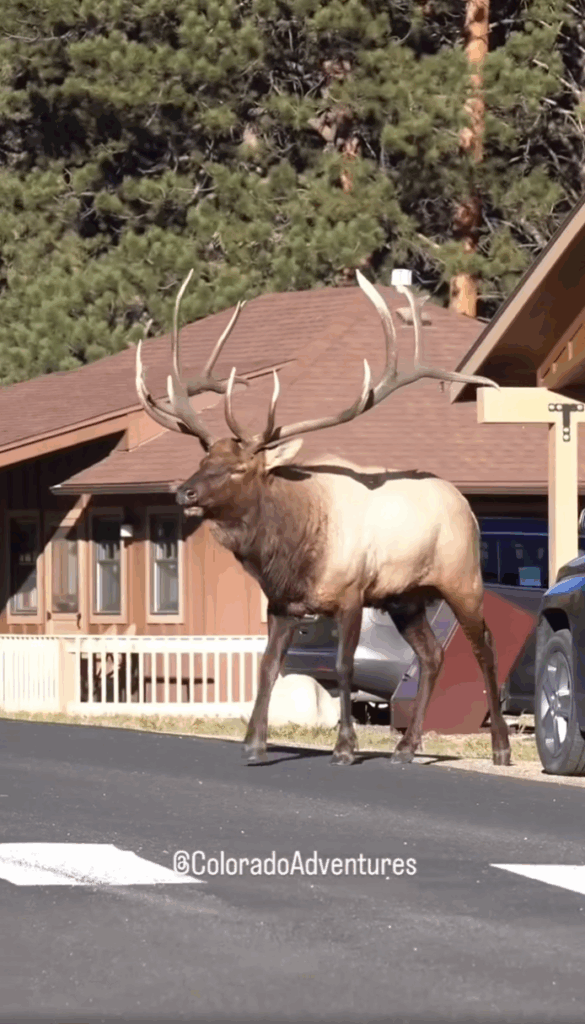When a photo of a massive antlered animal casually walking through a suburban Colorado neighborhood went viral, thousands of people rushed to comment: “That’s a moose!” Meanwhile, wildlife enthusiasts and locals were quick to correct them: “Nope, that’s an elk.”

But here’s the twist — those who called it a moose?
They’re not entirely wrong.
This article breaks down why so many people confuse elk and moose — and how history, language, and biology all play a role in the mix-up.
1. Blame the English Language: Elk Means Something Different Depending on Where You’re From
The root of the confusion begins with the language itself.
In North America:
-
The animal seen in the photo is called an elk (Cervus canadensis), also known as wapiti.
-
The moose (Alces alces) is a different, larger species with broader, shovel-shaped antlers.
But in Europe, particularly in the UK:
-
The word “elk” refers to what North Americans call a moose.
-
What Americans call an elk is often referred to as a red deer in Europe.
So when a British viewer says “That’s an elk” while pointing at a moose, they’re technically correct by European standards — it’s just that in the U.S., the terms are reversed.
In short, British “elk” = American “moose”.
2. Visual Similarities: Why Your Brain Might Trick You
Even for wildlife enthusiasts, elk and moose can seem similar at a glance:
-
Both are large, majestic members of the deer family.
-
Both have massive antlers — particularly impressive on males.
-
Both roam wild in forested, mountainous regions of North America.
However, biologically and visually, they’re quite distinct:
| Feature | Elk (Cervus canadensis) | Moose (Alces alces) |
|---|---|---|
| Antlers | Long, branching (tree-like) | Wide, flat (shovel-like) |
| Face | Slim, long snout | Bulky, drooping nose |
| Size | Up to 700 lbs | Often 1,000+ lbs |
| Neck Mane | Often has a shaggy mane | Shorter, less distinct |
| Behavior | Herd animals | Usually solitary |
In the viral photo, the animal has tall, tree-branch antlers and a more slender, brown-toned body — classic features of a bull elk. But from a distance, its size and stature could easily be mistaken for a moose.
3. The Internet Is a Global Place
It’s important to remember that social media platforms like Instagram or TikTok are global — people from the UK, Canada, the U.S., Germany, and beyond are all seeing the same video. And with that come differences in terminology.
So when a European commenter says “Look at that moose!” while pointing to an American elk, they’re linguistically accurate in their own cultural context — even if North Americans will insist otherwise.
4. Pop Culture Doesn’t Help
Let’s not forget how media fuels the confusion:
-
Animated films and cartoons often use the terms interchangeably or inaccurately.
-
Few people grow up learning the difference between a wapiti and a red deer.
-
Even nature documentaries can vary in terminology depending on where they’re produced.
When you combine inconsistent language, similar body shapes, and a global online audience — the confusion between elk and moose starts to make a lot more sense.
Conclusion: You’re Not Wrong, But Here’s What You Saw
So, was the animal in the photo a moose?
In North American terms: No.
In European terms: Kind of.
What you actually saw is a magnificent bull elk, likely captured somewhere in Colorado — a common sight in the region during rutting season. Still, if you shouted “Moose!” in excitement, don’t feel too bad.
Blame history. Blame geography. Blame English. Just don’t blame yourself. 🦌